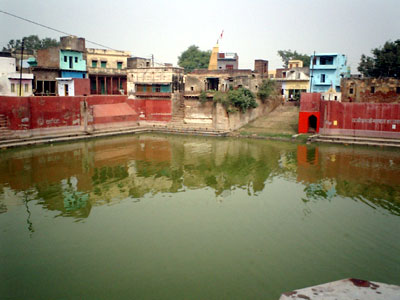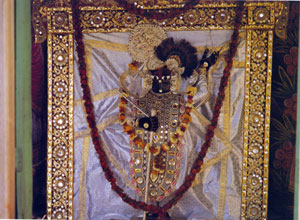The seven sacred cities or the saptapuris are the most sacred/holy cities according to Holy Scriptures. These are: Ayodhya, Mathura, Haridwar, Kashi, Kanchi, Ujjain and Dwarka.
a) Ayodhya: It is a very holy city and is an important pilgrimage site. Lord Rama was born and had many of His pastimes here. It is said to have once had a perimeter of 96 miles and was the capital of Koshala. It is on the banks of the Saryu River. Ayodhya is 6 km from the town of Faizabad. Rama Janma Bhoomi, where Lord Rama was said to have taken birth, is here. There is small Lord Rama temple here. There are over 100 temples in Ayodhya. Also called OUDH, or AWADH city. It lies on the Ghaghara (Gogra) River near Faizabad. Ayodhya is regarded as one of the seven sacred cities of the Hindus; it is revered because of its association, with the great Indian epic Ramayana, with the birth of Lord Rama and with the rule of his father, Dasharatha. According to Ramayana, the city was prosperous and well fortified and had a large population. In traditional history, Ayodhya was the early capital of the kingdom of Kosala, while, in Buddhist times (6th-5th century BC), Sravasti became the kingdom's chief city. Scholars generally agree that Ayodhya is identical with the city of Saketa, where the Buddha is said to have resided for a time. Its later importance as a Buddhist centre can be gauged from the statement of the Chinese Buddhist monk Fa-hsien in the 5th century AD that there were 100 monasteries there. There were also a number of other monuments, including a stupa (shrine) reputed to have been founded by Asoka (3rd century BC).The Kanauj kingdom arose in Ayodhya, then called Oudh, during the 11th and 12th centuries. The region was later included in the Delhi sultanate, the Jaunpur kingdom, and, in the 16th century, the Mughal Empire. Oudh gained a measure of independence early in the 18th century but became subordinate to the British East India Company in 1764. In 1856 it was annexed by the British; the annexation and subsequent loss of rights by the hereditary land revenue receivers provided one of the causes of the Indian Mutiny in 1857. Oudh was joined with the Agra Presidency in 1877 to form the North-Western Provinces and later the United Provinces of Agra and Oudh, now Uttar Pradesh state.
Janma-sthana is where Lord Rama was said to have been brought up. There is a popular temple dedicated to Hanuman called Hanuman-gadhi. Kanak Bhavan and Kala Rama temple, both have Dieties of Sita-Rama. There is a nice area by the river surrounding Laksman Ghat. Vashishtha Kund is a temple with a small round kund, like a well. Lord Rama is said to have performed yajna at Treth ka Mandir. Other temples are Kshireswara Nath temple and Bharata Kund.
b) Mathura: Mathura is an extremely important pilgrimage city where Lord Krishna was born. It is 150 km south of Delhi and 14 km from Vrindavan. The main temple here is called the Keshava Deo temple. Vishramaghat is a bathing ghat on the bank of the Yamuna where Krishna rested after killing King Kansa. There is another place called Rangabhumi where Krishna killed Kansa on the hill called Kansatila. Many pastimes from the Srimad Bhagavatam and other Puranas took place in Mathura.
 |
 |
‘Braj’ – ‘Mathura’ – ‘Vrindaban Dham’ not only refer to the place located in the cultural and linguistic region of ‘Braj’ situated on the banks of the Yamuna river in present-day Uttar Pradesh, but in spiritual sense, this is the celestial transcendental pastimes (Lita). The mind which is full of love and devotion of Shri Krishna, which is the goal of every Krishna–bhakata, is also called Vrindaban. The essential attribute of all these ceoceptualisations is the presence of Supreme Lord Krishna and His retinue. In the eyes of Devotees, the terrestrial Vrindaban is identical with the celestial one.
In the minds of devotees, there is no, doubt that Spiritual abode of Krishna ‘decended’ as earthly ‘Braj Dham’, elaborately explained the concept of the ‘Dham’, based on ‘Padma Puran’ and ‘Brahma-Samhita’. The transcendental abode of Shri Krishna – Goloka Vrindaban is identical with terrestrial Vrindaban Dham. This terrestrial ‘Dham’ is as much transcendental as the celestrial abode.
All the religious books describe the glories of Brajbhoomi- the land where Shri Krishna was born and spent his youth. Mathura and Vrindaban, which fall in the Braj, are the most sacred places of pilgrimage according to Holy Scriptures. Their significance has been very well described in Puranas and other holy books.
c) Haridwar: One of the Saptapuris as well as four places of Kumbha-Mela (To know more about Haridwar please click here)
d) Kashi (Varanasi): Saptapuri as well as Jyotirlinga,
Varanasi is said to be the oldest inhabited city in the world. There are supposed to be 2000 temples here. It is on the bank of the Ganges, 125 km east of Allahabad. The city was originally called Kashi or the city of lights. It is said that the first jyotirlinga, the fiery pillar of light, came through the earth here and flew into the sky. Therefore, Varanasi is also called Kashi, city of light. The Muslim rulers gave it the name Benares. It is believed that anyone who dies in Varanasi attains moksha (liberation).
 |
 |
Many saints and sages have come to Varanasi including Sri Chaitanya Mahaprabhu, Lord Buddha, Sankaracharya and Sri Ramanuja. One of the highlights of a trip here is to see the city from the waters of the Ganges at sunrise. There is a five mile parikrama path that goes around this sacred city. There are 81 bathing ghats and other holy kunds or sacred tanks. The important ghats here are Manikarnika, Dashashwamedha and Pancha-ganga, Asi Sangam and Varana Sangam. Adi Keshava Vishnu temple is located where the Ganga meets the Varana River. Famous temples are Vishvanath temple, Bindhu Madhava, Adi Keshava temples, Durga temple and Sankat Mochan temple. The present name of Kashi is Varanansi which is the most important pilgrimage sites in India and also a major tourist attraction. Varanasi situated on the banks of the sacred Ganga. Its mention is found in the ‘Mahabharata, Ramayana, Srimad Bhagavatam and the Puranas which date back 5,000 years.
Varanasi is a centre of learning especially for Sanskrit scholars. There is a five-mile ‘parikarma’ path that goes around this sacred city. There are 81 bathing ghats and other holy ‘Kunds’ or sacred tanks. The three most important ghats are Manikarnika, Dashash wamedha and Panch-Ganga. To bathe at these ghats is called ‘tri-tirthi Yatra.23 Sarnath is 10 km away and is famous for the place where Lord Buddha first preached about enlightenment twenty five centuries ago. The famous Shiva temple is called Vishwanath Temple (Golden Temple) and is visited by a large number of pilgrims. There are many other shrines in Varansasi.
e) Kanchi (Kanchipuram): Kanchipuram is known as the ‘Golden city of Temples’. It is considered one of the seven main sacred cities of India. It has over a hundred temples and is believed to give eternal happiness to one who goes there. It is said that ‘Ka’ (Brahma) ‘Anchi’ (worshipped) Lord Vishnu at this place and that is why the city was given the name Kanchi, Puram means ‘city’. Kanchi was the capital of the Pallavas from 7th to 9th centuries. The city is divided into two main parts Sivakanchi and Vishnukanchi. Kailasanatha and Vaikuntha Perumal temples were the most important temples built by the Pallavas, Varadaraja. Kamakshi and Ekambareswara temples were originally built by the Cholas but were added onto by the Vijayanagar and Nayak rulers. There are thirteen Divya Desam temples in the area of Kanchipuram namely Sri Vaikunthaperumal temple, Sri Varadaraja Swami temple, Sri Adi Varaha Perumal temple, Sri Deeparakast temple, Sri Yathoktakari temple, Sri Alagiyasingar temple, Sri Nilathingal Thundalthan Perumple temple and others. Kanchipuram is also known as Satyavrata Kserta due to Aswamedha sacrifice performed here by Lord Brahma. Throughout its history, kanchipuram remained one important pilgrimage centre. (25) At present many pilgrims visit this place.
 |
 |
f) Ujjain: One of the Saptapuris, a place of Khumba Mela and a place of Jyotirlinga.
Ujjain is situated on the bank of the Shipra river, which is one of the western most tributaries of Ganga. It is said that Lord Shiva killed the demon Tripura at Ujjain. Ujjain is the place where Sandipani Muni instructed Lord Krishna and Balarama. It was called Avantipuri when Lord Krishna studied here. Gopal Mandir is a famous Krishna temple with a silver deity. This temple was constructed by Maharaja Adult Rao Scindia’s queen in the 19th centruy. The Kumbh Mela in Ujjain is held in Chaitra (March-April). About 3 million people come for bathing. Mahakaleswar temple is a famous temple of Ujjain which contains one of the 12 shiva Jyotirlingas. It attracts thousand of pilgrims and is by far the most visited temple in Ujjan.
g) Dwarka (Please see in Char Dham): In the west one of the four dhams is Dwarka, which is also one of the seven holy cities or Saptapuris. Archaeological excavations indicate that Dwarka is built on four former cities. Much of the present town was submerged by the rising sea levels. There is evidence to suggest that the city was a large poart at least as far back as the 15th century B.C.
One of the four original Maths founded by Adi Shankaracharya is in Dwarka.Both Shri Ramanujacharya and Shri Madhavacharya visited this place. In the middle of the town is Dwarkadheesh temple. The five stareyed temple is buit on 72 pillars. The temple spire is 235 ft. high. From the temple domes waves a multicoloured flag decorated 84 feet long - Lord Krishna’s great grandson Vajranabha is said to have built the original temple of palace. The sanctum of the temple dates back at least 2,500 years. There are two entrances to the temple the main entrance is called Swargadwara. Outside this doorway are 56 steps that lead to the Gomati River. The main deity in this temple is Lord Dwarikadheesh on the centre attar. To the rigt of the main deity there is a temple having the deity of Lord Baldev Ji. The temple to the left of the main deity hosts a big deity of Pradyumora and a small deity of Aniriddha, the son and grand son of Lord Krishna.
|